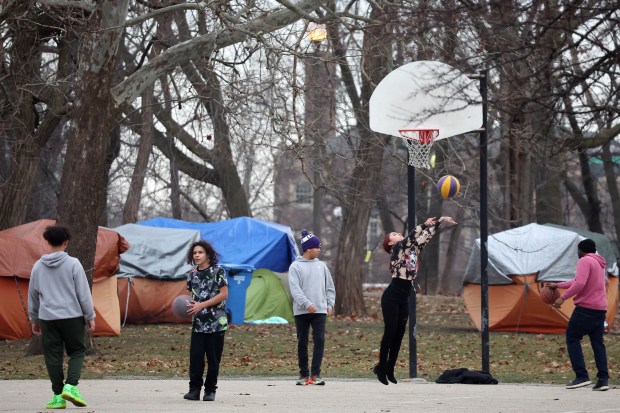The city and state are in the planning stages to combine Chicago’s legacy homeless shelter system with its system for migrants, according to government officials, and turn it into a unified shelter structure, an idea advocates for the homeless have long championed.
The “One System Initiative” will shift a “permanent shelter management to the non-profit workforce,” Illinois Department of Human Services spokesperson Daisy Contreras said in a statement. Currently, the city contracts with Favorite Healthcare Staffing, whose sizable overtime has contributed to tens of millions of dollars in city payments to the firm staffing the city’s migrant shelters.
The state’s office to prevent and end homelessness will lead the initiative with more than 25 community-based agencies participating, Contreras said. Planning sessions are set to begin at the end of April and go through the spring.
Beatriz Ponce de Leon, Chicago’s deputy mayor of immigrant, migrant and refugee rights, said officials ultimately hope to fully transition to a unified shelter system — and look beyond shelter to affordable housing.
The goal, she said, is “to serve people regardless of if they’ve been here for five days or five years or their whole life.”
Homeless advocates say combining the shelter systems will take time and coordination, but will be beneficial.
The two shelter systems — catering toward the homeless and migrant populations in Chicago respectively — currently compete for limited affordable housing resources, said Nicole Bahena, vice president of community partnerships for All Chicago, in a written statement to the Tribune.
“Consolidating will help reduce competition and reduce wasted time and effort,” Bahena said.
The city opened its first shelters catering to migrants in early September 2022 after Texas Republican Gov. Greg Abbott began sending migrants to Chicago and other sanctuary cities on buses and planes, in part to draw attention to strained resources in border cities. But Chicago’s open-armed approach to welcoming migrants quickly crashed into the reality of limited resources and past disinvestment in city neighborhoods.
The city and state are now housing 8,724 migrants in 17 buildings, according to city data released Sunday. Nearly 40,000 migrants have passed through Chicago since Abbott’s busing began, and more arrive each week.
Bahena said the separate system that was set up for migrants is different from the one typically used in the homeless sector. Providers helping asylum-seekers may be new to housing and homelessness. Combining these program models, she said, may pose challenges.
“This will require new staff positions including system coordinators, translators and other staff to support a coordinated system that must be adaptable as we learn,” she said in the statement.
Ponce de Leon said the plan is still in its infancy, but they hope to have a more public report at the end of the summer. She said the state’s chief homelessness officer and the city’s new homelessness officer are involved in the discussions.
Sam Paler-Ponce, interim associate director of policy for the Chicago Coalition for the Homeless, said combining the systems is a “move in the right direction.” The biggest benefit, he said, is that asylum-seekers will have a wider array of supportive services made available to them: employment, food and health care.
But combining the systems could also lead to an “influx in shelter bed demand,” he said.
According to recent data from the organization, there are more than 68,000 people currently experiencing homelessness in Chicago. Nearly 37,000 people accessed homeless services throughout the year. These figures don’t include migrants.
As the city faces budget concerns and closes shelters, volunteers and migrant advocates expect an increase in street homelessness and people “doubled up,” or sharing a house with others due to economic hardship or a similar reason.
They say the solution is to provide “wraparound” services and affordable housing, instead of increasing shelter capacity.

Mayor Brandon Johnson has already closed more than 10 shelters from the height of shelter operations in mid-January. He has also imposed 60-day-limits for migrants staying at shelters, with case-by-case exemptions for people with medical conditions, pregnant women and families with children, among other qualifications.
The number of evictions from shelters was slow when they began in mid-March, but has recently increased, with 51 people leaving the system on Saturday. A total of 270 individuals had exited the system as of Sunday, and that number will likely go up through the end of April.
There are several key demographic differences between migrants staying in shelters and Chicagoans experiencing homelessness, said Jenn Torres, a mutual aid volunteer who has helped migrants across the city.
Torres said asylum-seekers who have trekked for thousands of miles to make it to Chicago have distinct mental health needs, for instance, and there are far more families.

The Chicago Public Schools system is federally required to support the enrollment and education of students who are homeless or in temporary living situations. This number has gone up substantially over the past year, providing a window into the number of migrant children relying on city services.
There were 225,250 students in temporary living situations enrolled at the end of March — a 48% increase from last March, and more than ever recorded at this time of year, according to data provided by the Chicago Coalition for the Homeless.
Torres worries about the Chicago homeless shelter system’s ability to provide for migrants’ needs. To make matters more difficult, most asylum seekers can’t work legally.
“We have a lackluster shelter system to begin with,” she said. “But (migrants) can’t pay rent, and they have children.”
She and other volunteers are already preparing for a time when, like last summer, migrants may be camped out in police station lobbies across the city.



